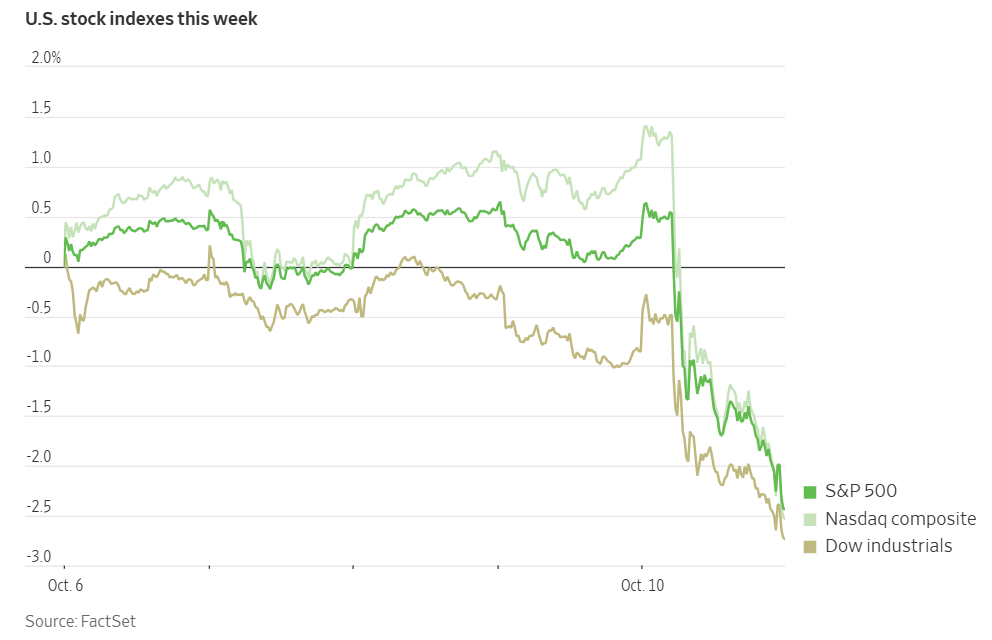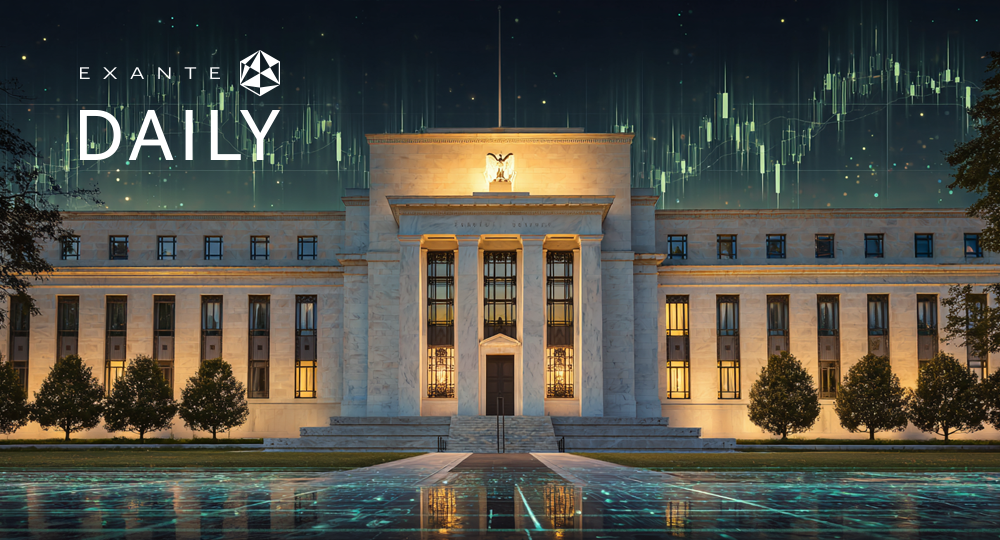
Liberation Day 2.0 redux?

Key data to move markets today
USA: Monthly Budget Statement and a speech by Philadelphia Governor Anna Paulson
UK: A speech by BoE external member Catherine Mann
GLOBAL: IMF and World Bank Fall Meeting and OPEC Monthly Market report
US Stock Indices
Dow Jones Industrial Average -1.90%
Nasdaq 100 -3.49%
S&P 500 -2.71%, with 10 of the 11 sectors of the S&P 500 down

US equities declined sharply on Friday following President Trump’s announcement on Truth Social, where he suggested he may cancel a meeting with China’s president and was weighing a substantial increase in tariffs on Chinese imports. The resulting selloff was significant enough to erase both the S&P 500 and the Nasdaq Composite’s weekly gains.
Both indices experienced their steepest single-day declines since April, with the S&P 500 falling by -2.71% and the Nasdaq Composite by -3.56%. The Dow Jones Industrial Average also fell, dropping nearly 900 points, or -1.90%.
For the week, the S&P 500 declined -2.79%, the Nasdaq Composite fell -3.21% and the Dow Jones Industrial Average was -2.60%.
Shares in US semiconductor stocks faced considerable pressure on Friday; AMD declined by -7.78% and Broadcom by -5.91%. Market volatility also intensified, with the VIX index surpassing 21.
In corporate news, Alphabet’s Google became the first company to receive ‘strategic market status’ in the UK, subjecting its online search and advertising operations to increased scrutiny from the nation’s antitrust authority.
China imposed new port fees on US vessels and initiated an antitrust investigation into Qualcomm, adding to a series of reciprocal trade actions as Presidents Xi Jinping and Donald Trump vie for leverage ahead of a pivotal meeting.
Chevron requested authorisation to drill up to 10 wells offshore Namibia, in a region emerging as a major hub for oil and gas exploration in Africa.
Leaders at AI computing firm CoreWeave collectively sold more than $1 billion in shares following the expiration of a stock lockup in mid-August. This placed them among the top 10 individual insider sellers for the third quarter.
Carlyle reached an agreement to acquire control of BASF’s coatings division, establishing an independent entity valued at €7.7 billion.
S&P 500 Best performing sector
Consumer Staples +0.25%, with PepsiCo +3.71 %, Philip Morris International +2.31%, and Campbell’s +1.67 %
S&P 500 Worst performing sector
Information Technology -3.97%, with Synopsys -9.39%, Teradyne -9.03%, and Super Micro Computer -8.83%
Mega Caps
Alphabet -1.32%, Amazon +1.12%, Apple -1.56%, Meta Platforms +2.18%, Microsoft -0.47%, Nvidia +1.83%, and Tesla -0.72%
Information Technology
Best performer: Motorola Solutions -0.29%
Worst performer: Synopsys -9.39%
Materials and Mining
Best performer: Amcor +1.41%
Worst performer: Mosaic -9.24%
European Stock Indices
CAC 40 -1.53%
DAX -1.50%
FTSE 100 -0.86%
Commodities
Gold spot +1.02% to $4,017.34 an ounce
Silver spot +2.35% to $50.27 an ounce
West Texas Intermediate -5.33% to $58.24 a barrel
Brent crude -4.66% to $62.17 a barrel
Gold surged above the $4,000-per-troy ounce threshold on Friday, marking its eighth consecutive weekly advance as heightened concerns over potential new US tariffs on China prompted investors to seek safe-haven assets.
Spot gold increased by +1.02% to $4,017.34 per ounce. It was +3.38% for the week.
Bullion reached an all-time high of $4,059.05 per troy ounce last Wednesday. Traditionally, gold is regarded as a hedge against uncertainty, and recent geopolitical tensions, robust central bank purchases, inflows into ETFs, expectations of lower US interest rates, and economic uncertainty related to tariffs have all played a role in supporting its rally. Year-to-date, gold is +53.11%.
On Friday, the US President announced that he saw no reason to meet with China’s President Xi Jinping in South Korea as had been previously scheduled. He indicated, via a Truth Social post, that the US is considering a substantial increase in tariffs on Chinese imports.
Brent and US WTI crude futures declined sharply on Friday, each falling more than $3 per barrel, or over 3%, as the US President’s threat to raise tariffs on China heightened concerns about demand in an already oversupplied market. Brent crude futures fell $3.04 or -4.66% to $62.17 per barrel, marking the lowest closing price since 5th May. US WTI crude settled at $58.24 per barrel, down $3.28, or -5.33%, representing its lowest level since early May.
On a weekly basis, WTI declined by -4.04% while Brent fell by -3.43%. Increased production from OPEC, additional output from North and South America, and a drop in geopolitical risks following the Gaza ceasefire agreement have all contributed to the downward pressure on prices, compounded by the US President’s tariff announcement on Friday morning.
Since 2023, the Iran-aligned Houthi movement in Yemen has attacked several vessels, mainly those they associate with Israel, citing solidarity with Palestinians amid the Gaza war. With the ceasefire in place, market attention shifts back to the anticipated oil surplus, as OPEC moves forward with scaling back production cuts. The smaller-than-expected increase in output agreed by OPEC+ on 5th October has alleviated some concerns about oversupply.
Note: As of 5 pm EDT 10 October 2025
Currencies
EUR +0.48% to $1.1618
GBP +0.45% to $1.3358
Bitcoin -8.49% to $111,204.79
Ethereum -14.21% to $3,739.28
The US dollar declined on Friday following the President's announcement of potential tariff increases against China. This reignited concerns regarding the effects of the ongoing tariffs saga on the American economy.
The dollar index fell -0.55% to 98.85. Nevertheless, the dollar posted a weekly gain of +1.17%—its largest since September 2024—bolstered by fiscal uncertainties that weighed on the Japanese yen and the euro throughout the week.
Market participants remain attentive to developments surrounding the reopening of the US federal government, as the release of key economic data will inform future Fed policy decisions. The US Bureau of Labor Statistics confirmed on Friday that it will publish September’s consumer inflation report on 24th October, thereby assisting the Social Security Administration in determining the annual cost-of-living adjustment for 2026.
The euro appreciated by +0.48% against the dollar on Friday, reaching $1.1618. However, it registered its largest weekly decline since July, falling -1.05%. The ongoing political deadlock in France has complicated efforts to enact a fiscally conservative budget and heightened investor concerns about the nation's worsening deficit.
The British pound rose +0.45% on Friday but ended the week down -0.89% at $1.3358.
The Japanese yen weakened over the week, driven by doubts that the BoJ will raise interest rates again this year following fiscal dove Sanae Takaichi’s unexpected election as leader of the ruling party. These developments have increased speculation that Japanese authorities may intervene to support the currency. Finance Minister Katsunobu Kato voiced concerns over excessive volatility in the foreign exchange market on Friday, marking the first instance of verbal intervention from the Ministry of Finance regarding sharp movements in the yen.
The yen gained +1.22% against the US dollar on Friday, trading at ¥151.15 per dollar. Despite this, the dollar posted a +2.51% weekly increase against the yen, marking its strongest weekly performance since September 2024. Takaichi stated on Thursday that she does not intend to trigger a pronounced decline in the yen and emphasised that while the BoJ sets monetary policy, its decisions must align with government objectives.
Although Takaichi was expected to be confirmed as prime minister in a parliamentary vote scheduled for 15th October, the date will likely be postponed after the junior coalition partner, Komeito, withdrew its support, ending their 26-year alliance.
Fixed Income
US 10-year Treasury -10.8 basis points to 4.036%
German 10-year bund -5.6 basis points to 2.646%
UK 10-year gilt -7.5 basis points to 4.674%
US Treasury yields declined to multi-week lows on Friday, as uncertainty stemming from the ongoing government shutdown kept movements in sovereign debt yields subdued. The suspension of key economic indicator releases due to the shutdown has further contributed to this cautious market environment.
In Friday's session, the yield on the US 10-year Treasury note was-10.8 bps to 4.036%, marking its lowest level in over a month. Similarly, the 30-year Treasury bond yield was -10.3 bps to 4.621%, after briefly hitting its lowest point since 5th September. On the short end of the yield curve, the two-year Treasury yield—which generally reflects interest rate expectations—fell -9.3 bps to 3.512%.
For the week, the two-year yield was -6.2 bps, the 10-year yield fell by -8.5 bps, and the 30-year yield was -9.0 bps. The spread between the two-year and 10-year Treasury notes narrowed by 2.3 bps over the week, settling at a positive 52.4 bps compared to 54.7 bps the previous week.
According to CME Group's FedWatch Tool, Fed funds futures traders are pricing in a 98.3% probability of a 25 bps rate cut at October’s FOMC meeting, higher than last week’s 96.2%. Traders are currently anticipating 72.9 bps of cuts by year-end, higher than the 71.5 bps expected last week.
Across the Atlantic, the risk premium required by investors to hold French government bonds over German Bunds widened only marginally, as markets closely monitored President Emmanuel Macron’s efforts to resolve the ongoing political crisis. The broader European bond market remained largely unfazed by renewed political turmoil in France, with the 10-year yield spread between French and German bonds remaining slightly above levels seen before the resignation of French Prime Minister Sébastien Lecornu.
Market focus on Friday centred on President Macron’s critical meeting with mainstream political leaders, culminating in the reappointment of Lecornu later that day. Despite comments from France’s central bank chief regarding the negative impact of political uncertainty—estimated at a loss of at least 0.2 percentage points in economic growth and further risks to business and consumer confidence—markets remained stable.
The German 10-year Bund yield fell -5.6 bps to 2.646%, recording a weekly decrease of the same magnitude. The yield on Germany’s two-year Schatz, which is more sensitive to expectations for ECB policy, fell by -4.5 bps to 1.960%, contributing to a weekly drop of -6.9 bps. At the long end, the German 30-year yield was -5.5 bps on Friday and closed the week -4.1 bps lower at 3.225%.
France’s 10-year yields fell -5.7 bps on the day to 3.474%, while the spread between French OATs and German Bunds at the 10-year maturity widened to 82.8 bps from 81.2 bps the previous week, after reaching a high of 87.9 bps earlier in the week—the highest since 13th January —amid concerns about France’s fiscal outlook.
The German-Italian 10-year yield spread narrowed slightly by 0.7 bps to 80.9 bps, compared with 81.6 bps the week before. Italy’s 10-year yields declined -5.6 bps on Friday, finishing the week -6.3 bps lower at 3.455%. On Friday evening, S&P affirmed Italy’s credit rating at BBB+ with a stable outlook, following Fitch’s upgrade last month.
Note: As of 5 pm EDT 10 October 2025
Global Macro Updates
Trade war fears renew as the US President threatens tariffs on China. Markets experienced a significant decline following an extensive post on Truth Social by President Trump, in which he characterised China’s recent stance on rare earths as ‘sinister and hostile,’ citing their implementation of export controls. He asserted that China has been ‘lying in wait’ and emphasised that Beijing should not be permitted to hold the world hostage through such measures.
President Trump indicated that the US is contemplating a substantial increase in tariffs on Chinese goods, along with a range of additional countermeasures. He also stated that there is no justification for meeting with China’s President Xi on the sidelines of the upcoming APEC conference in South Korea later this month. This much anticipated meeting, as suggested by Treasury Secretary Bessent, could have helped pave the way for a major agreement.
These remarks follow several actions by China, including an antitrust filing against Qualcomm, reports of customs officials obstructing the import of Nvidia chips designed specifically for China, the imposition of stricter controls on rare earth exports, and the introduction of new port fees for US vessels. While international trade tensions had subsided somewhat in recent weeks, some observers note that the US and China may be manoeuvring for leverage ahead of the next round of direct talks scheduled for November.
October Michigan Consumer Sentiment slightly better than consensus. The preliminary Michigan Consumer Sentiment Index for October registered at 55.0, surpassing consensus expectations of 54.0, though slightly below the September reading of 55.1.
The current conditions component rose by 0.6 points to 61.0, while the expectations index declined by 0.5 points to 51.2. Short-term (one-year) inflation expectations edged down by 0.1 percentage points to 4.6%, whereas longer-term (five to ten-year) inflation expectations remained steady at 3.7%.
Despite limited economic data releases this week, the market response to the report was muted, as the results largely aligned with forecasts. Early commentary from analysts indicated that inflation is off its post-Liberation Day highs, yet remains elevated compared to levels observed a year ago. Economists also noted that the report continues to reflect cautious sentiment regarding labour market conditions and inflation, which perpetuate uncertainty throughout the broader economy. Nonetheless, analysts observed that consumer spending remains resilient in the face of a challenging macroeconomic environment.
While every effort has been made to verify the accuracy of this information, EXT Ltd. (hereafter known as “EXANTE”) cannot accept any responsibility or liability for reliance by any person on this publication or any of the information, opinions, or conclusions contained in this publication. The findings and views expressed in this publication do not necessarily reflect the views of EXANTE. Any action taken upon the information contained in this publication is strictly at your own risk. EXANTE will not be liable for any loss or damage in connection with this publication.
Ten artykuł jest publikowany wyłącznie w celach informacyjnych i nie powinien być traktowany jako oferta lub zachęta do kupna lub sprzedaży jakichkolwiek inwestycji lub powiązanych usług, do których można się tu odwołać. Obrót instrumentami finansowymi wiąże się ze znacznym ryzykiem strat i może nie być odpowiedni dla wszystkich inwestorów. Wyniki osiągnięte w przeszłości nie są wiarygodnym wskaźnikiem wyników w przyszłości.
Zarejestruj się i otrzymuj informacje rynkowe
Zarejestruj się i otrzymuj
informacje
rynkowe
Subskrybuj teraz



